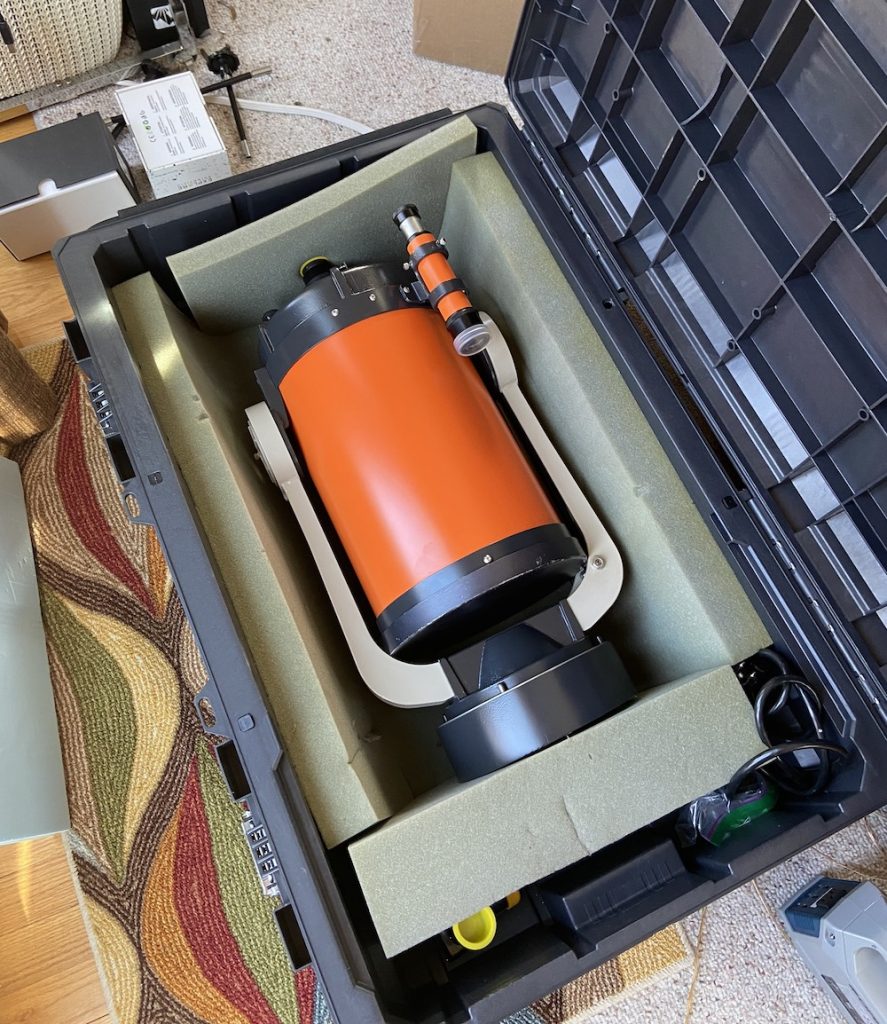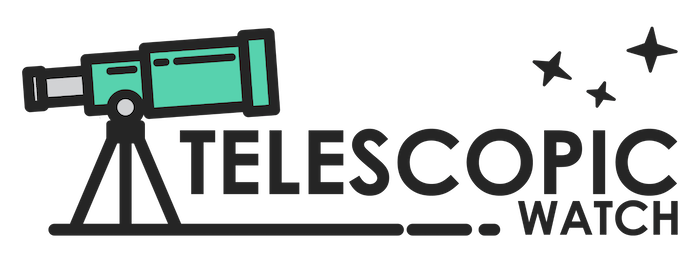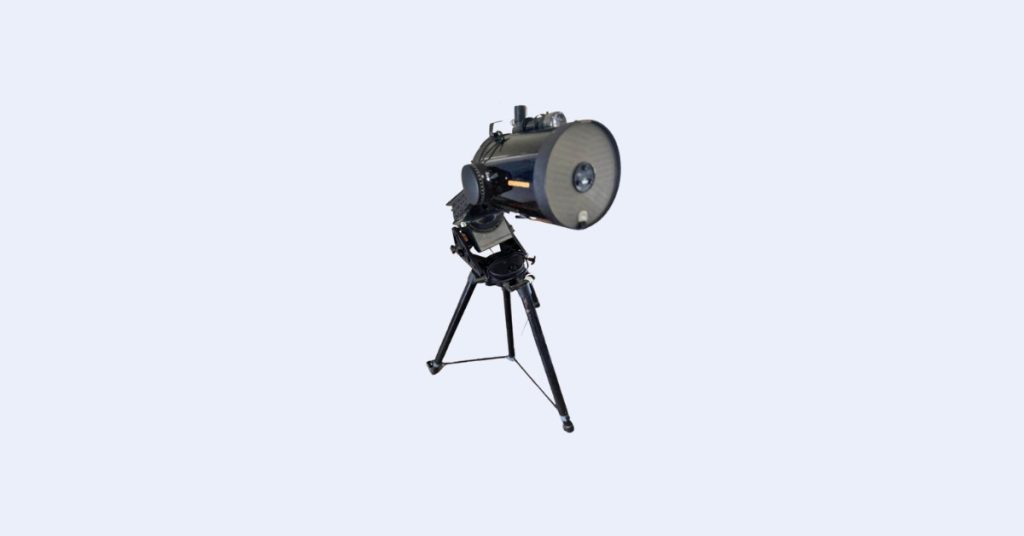The C8 Optical Tube
The C8 is Celestron’s oldest mass-produced telescope, having debuted in 1970. Other than small changes to the manufacturing and coating processes, the C8 has hardly changed in the past 50+ years.
C8 is an 8” Schmidt-Cassegrain with an aperture of 203.2 mm (8″) and a focal length of 2,032 mm, giving it a focal ratio of f/10. Its 8” aperture is enough to show me deep-sky objects and planets with a fair amount of detail without being too unwieldy. While 2032 mm is a bit long of a focal length for larger objects, it doesn’t make me feel as claustrophobic as the larger Schmidt-Cassegrains in Celestron’s lineup.
The secondary mirror obstruction in the front of the optical tube is 64 mm wide, accounting for 31% of the aperture diameter but slightly less than 10% when we calculate in terms of aperture area. This secondary assembly of the current generation of C8 OTAs is also Fastar or HyperStar compatible.
Since the C8 is a Schmidt-Cassegrain, I need to collimate it every so often, but not nearly as often as most Newtonian reflectors.
Altogether, the C8 optical tube weighs about 13 pounds and is about 17 inches long. This means it’ll fit in a very small space, such as a large backpack, suitcase, or dedicated carrying case.

Simply put, the C8 is one of the best amateur scopes on the market that put Celestron on the map. While there are better and cheaper scopes out there, there aren’t many, and the C8 continues to be a classic.
The Advanced VX Mount
The Advanced VX is Celestron’s cheapest GoTo German Equatorial Mount (GEM).
At about 35 pounds altogether, the Advanced VX may sound a little heavy, but we can break it into plenty of smaller pieces. The heaviest is the tripod at 18 pounds, and the mount head weighs 17 pounds.
The tripod has 2-inch diameter stainless steel legs, and the leg spreader has fairly standard holes drilled for keeping 1.25- and 2-inch eyepieces.
The AVX comes with Celestron’s standard NexStar+ hand controller (the variant for equatorial mounts). The NexStar+ hand control has a database of over 40,000 objects, including the entire Messier, Caldwell, NGC, and IC catalogues.
I can take advantage of nearly all of Celestron’s advanced technologies with the AVX, such as SkyAlign and CPWI (their new software developed in conjunction with PlaneWave), as well as their StarSense AutoAlign, SkySynch GPS, and SkyPortal WiFi add-ons.
My Take on AVX’s Payload Weight Capacity Rating
The AVX has a 30-pound stated payload capacity. This does not include counterweights: just the weight of anything attached to the dovetail saddle, and generally including the telescope, mounting rail, rings (if needed), eyepiece, finder scope, camera, autoguider, additional mounting hardware, and anything else riding on the mount.
Every company has their own method of rating mount capacity. In my experience, Celestron tends to be a bit liberal with the number. So, when they say 30 lbs., I wouldn’t recommend putting any more than 30 on it. I’m sure doing so would put you in jeopardy of voiding the warranty.
If I load the AVX up close to 30 lbs., I can well notice some performance problems, such as less accurate tracking and GoTo performance. I could also hear it straining to move the load. With this in mind, I find it odd that Celestron actually offers the mount with the C11 as an option, which weighs in at 27.5 lbs—just shy of the mount’s maximum. When you add in a diagonal, eyepiece, finder scope, and dew shield to the C11 package, you may easily find yourself over 30 lbs.
It’s also good to keep in mind that a common rule of thumb for astrophotography says that our total payload weight for imaging should be kept to one-half the mount’s rated maximum or less. So, for imaging, the C11 would be right out.
But with a tube weight of only 12.5 lbs., however, the C8 rides the mount fairly well. For visual use, I have plenty of room in the weight budget to add on heavy eyepieces and a better finder.
For imaging use, it comes pretty close to the recommended limit of 15 lbs., but a lightweight camera, along with a focal reducer and auto guider, while likely to be over the 50% mark, probably won’t be too bad for casual imaging use. And for planetary imaging, which uses short exposures or, more often, video capture, which puts less emphasis on the mount, there should be no problem here.
The Adaptability of AVX’s Mounting Saddle
The AVX’s mounting saddle is designed to handle two different styles of dovetail plate. Celestron refers to these as CG-5 and CGE. The CG-5 dovetail plate is pretty much identical to the Vixen-style dovetail. Both a Celestron CG-5 Dovetail and a standard Vixen style should work equally well.
The Celestron CGE-style dovetail, on the other hand, while being similar to the Losmandy D plate, is not quite the same, and because of this, the AVX cannot accept an actual Losmandy D. The actual Losmandy standard is slightly wider than the Celestron variant and doesn’t fit in the saddle properly. Additionally, I’ve noticed that the height of the dovetail portion itself, what is called the undercut, on the CGE is somewhat higher than the Losmandy D plate.
If the width wasn’t a problem, I could probably attach a Losmandy D, but I’m not sure I’d recommend it, as it may not clamp down tightly and may not provide a stable attachment.
Celestron does make an optional universal mounting plate for use with other scopes, but this is another cost. If you want a mount to handle multiple payloads and you’re not entirely brand-loyal, you may end up spending more on additional mounting plates.
The CG-5/Vixen-style variant is probably the best option if you do want to handle multiple payload options. It works just fine for most uses. It may be a little less stable for heavier payloads, particularly for imaging. Personally, I find the Vixen style much easier to mount, however.
The AVX’s Performance
The AVX was designed to be a mount both for imaging and visual observing. For visual observing, the requirements are far less than those needed for imaging. And here, I can state with confidence that the AVX does pretty well.
When properly set up and aligned, the GoTo’s performance and tracking are accurate and reliable. If I put an object in the eyepiece, I can expect it to stay there for as long as I intend to look at it. If I slew to another object, and assuming I did a good star alignment, the object should be in the center of the eyepiece.
Though heavier loads may make it strain and may decrease accuracy, it still generally performs well, making it definitely good enough for visual use.
But in one main area, the AVX is a bit of a disappointment. That’s backlash, particularly on the declination axis.
One of the chief reasons the discontinued CG-5 mount was never a great performer for imaging was the backlash, which could be pretty significant. The AVX’s backlash on the right ascension axis is definitely better than that of previous CG-5 models, but it may still appear a little high to some users, particularly those who require high precision for imaging.
Backlash is a problem caused by gears that don’t mesh together as closely as they should. This can be due to gears that aren’t being held tightly together or gears that aren’t properly sized to fit each other. The key symptom is some give in the axis.
While properly meshed gears should remain in contact with each other at all times, when gears aren’t properly meshed, there may be some looseness, which can result in back-and-forth wobbling. For visual use, this can be a nuisance, but I don’t usually consider it to be a problem (though it can decrease the accuracy of GoTo performance). But when imaging, it causes visible problems in the stars.
The AVX’s backlash on the declination axis, however, is a common complaint among users. There are some ways of reducing it, but it’s disappointing to me that Celestron didn’t do more in design and manufacture, particularly since this mount is designed with imaging in mind.
Overall, as designed, the performance of the AVX is hard to beat in its price class. But, again, that’s as-designed.
But All Is Not Well
If you do a little digging around on astronomy forums, you may find a higher than average number of complaints about the AVX. And while some of those complaints are about issues such as backlash, there are some bigger problems out there.
I’ve seen some users reporting significant problems with the mount’s electronic components. And here, it appears, is where Celestron has really dropped the ball. The horror stories are mostly regarding poor wiring and lower-quality electronic components in the mount itself—the hand control seems to be just fine here, unless problems in the mount lead to damage.
When a mount such as this stops working, for whatever reason, it becomes a high-priced doorstop.
The core of the problem may be traceable to quality control on the production line. While some of Celestron’s higher-end equipment, such as their more recently released mount, the CGX, appears to be well manufactured, the AVX, at its lower price point, appears to not get as much attention and care in the assembly process. As a result, many owners have had to send theirs back for warranty work or replacement. This can be frustrating, especially to those newer in the hobby.
Accessories
The Celestron AVX 8″ Schmidt-Cassegrain comes with a 1.25″ 25mm Plossl eyepiece providing 81x, along with a 1.25″ prism star diagonal. You’ll probably want at least one more eyepiece for higher magnification and, ideally, a 2″ diagonal and one or two 2″ wide-angle eyepieces for the widest possible field of view and lowest useful magnification.
The Advanced VX 8 SCT is supplied with a standard 6×30 finderscope. While a red dot finder would probably be easier to use and is all that is really required, the 6×30 doesn’t have any batteries to worry about draining and works fine for the simple task of aligning the GoTo mount.
Alternative Recommendation
Under £800
- The StellaLyra 10″ f/5 Dobsonian provides a broader field of view, superior accessories, enhanced light gathering and resolving power, and a considerably simpler setup compared to the Advanced VX 8″ SCT. With the Dobsonian mount, you can enjoy a stable and easy aiming experience, along with a range of included features like a 2″ dual-speed Crayford focuser, wide-angle low-power 2″ eyepiece, and a built-in cooling fan for the primary mirror.
- The Celestron StarSense Explorer 8″ Dobsonian delivers views at the eyepiece comparable to the Advanced VX 8″ SCT at a significantly lower price, featuring a lightweight, robust, and portable Dobsonian mount aided by Celestron’s StarSense Explorer technology for night sky navigation.
- The Sky-Watcher Virtuoso GTi 150P, while smaller and less capable in terms of light gathering and resolving ability than the Advanced VX 8″ SCT, offers a considerably wider maximum field of view, along with greater compactness and ease of setup. It also includes motorised tracking and GoTo, smartphone/tablet control, and the option for manual aiming without affecting tracking accuracy or damaging internal gears. The manual Heritage 150P version is also an excellent pick.
£800-£1200
- The Celestron StarSense Explorer 10″ Dobsonian lacks motorised slewing and tracking but features Celestron’s StarSense Explorer technology, which aids night sky navigation using your smartphone. Easy to set up in minutes, this lightweight telescope is simple to carry thanks to its optimised base and carry handles. However, it has limited accessories and features, so other 10″ Dobsonians may be a better option if these are important to you. The 8″ StarSense Explorer model is available at a lower price, but the 10″ model is recommended for its similar weight, volume, and ease of use.
- The Celestron NexStar 6SE, while smaller than the C8 XLT, offers a portable setup suitable for air travel and backpacking, albeit with limited aperture. With a HyperStar f/2 conversion kit, deep-sky and planetary astrophotography is possible, and the C6 XLT optical tube provides sharp views of brighter targets.
Over £1200
- The Celestron NexStar Evolution 8″ is easier to set up and assemble than the Advanced VX 8″, serving as a superior alternative if deep-sky astrophotography isn’t your primary focus. The alt-azimuth mount eliminates polar alignment or 2-axis balancing, and the telescope can be controlled via your smartphone/tablet or the included hand controller. The mount also features a built-in lithium battery, and a medium-power eyepiece is included in addition to a standard low-magnification ocular.
- The Sky-Watcher Explorer 200PDS NEQ6 Pro is an 8” Newtonian reflector ready for astrophotography, mounted on the top-quality NEQ6 Pro mount, making it an ideal choice for those seeking an out-of-the-box imaging setup. The NEQ6 Pro mount is vastly superior to the Advanced VX. Not only does it offer a higher payload capacity, but it also performs much better for imaging, with more accurate tracking/guiding due to its stepper motor drives and enhanced mechanical design.
- The Sky-Watcher Skyliner 250P FlexTube GoTo Dobsonian features GoTo/tracking capabilities, a larger aperture, and a lower price compared to the Advanced VX 8″ SCT, as well as a simpler and sturdier Dobsonian mount. The FreedomFind encoder system allows for manual aiming while the GoTo system remains active.
- The Celestron NexStar Evolution 6 shares the same design and features as the NexStar Evolution 8 but utilises the smaller C6 XLT optical tube. When choosing between the two, the 8″ model occupies barely any extra space, so we suggest opting for the Evolution 8 if it fits your budget. Alternatively, you could consider the NexStar 6SE or a larger 8-10” Dobsonian, but the Evolution 6 remains an excellent option.
Aftermarket Accessory Recommendations
The C8 XLT/Advanced VX package comes with rather few accessories, and you’ll definitely want to purchase several key upgrades and a few additional eyepieces to maximise the performance of this telescope, starting with a dew shield to reduce glare from nearby light sources making its way into the telescope, as well as slowing down frost or dew forming on the C8 XLT’s corrector plate and keeping some pollen, dirt, and dust away.
We highly recommend a 2” star diagonal, which allows you to achieve a much wider field of view with the C8 XLT optical tube than is possible with 1.25” eyepieces alone. A screw-on dielectric mirror diagonal is just a bit more crisp than the provided 1.25” prism while also providing a more secure connection between your telescope and eyepieces too.
A 38mm PanaView SWA eyepiece or a similar alternative for 53x magnification enables the widest possible field of view with the C8 XLT and a 2” eyepiece, ideal for sweeping views of large deep-sky objects such as open star clusters. A 16mm UWA (127x) is ideal for medium-high magnification (as is a 15mm redline for 135x if you’re on a tight budget), while a 10mm UWA or 9mm redline (203x or 226x) provides the maximum magnification atmospheric conditions will typically allow. If you frequently have exceptionally steady seeing conditions, a 7mm UWA or planetary eyepiece (290x) might also be worth picking up.
A UHC nebula filter can screw onto your eyepieces (or a 2” to 1.25” adaptor) and provides improved views of nebulae with the C8 XLT; while the scope’s limited field of view isn’t ideal for huge objects like the Veil Nebula the filter helps on objects like Orion or the Crab Nebula, improving contrast for more detail which is particularly helpful under light-polluted conditions.
The Advanced VX lacks a polar scope by default, making rough polar alignment using the hole in the polar axis both inaccurate and problematic for extended observing sessions or any kind of astrophotography, while setting up the All Star Polar Align is fairly time-consuming. To remedy this issue, the default polar scope from Celestron works just fine. Moreover, a DC power supply, such as the Celestron PowerTank Lithium, is required to power the mount in the absence of an AC power cord.
What can you see with the Advanced VX 8″ SCT?
The large aperture and moderately long focal length of the C8 make it great for viewing the Moon, planets, double stars, and smaller deep sky objects. Large open clusters and nebulae won’t fit in the field of view, but the C8 is great for viewing smaller galaxies like M82 and M51, globular clusters like M13, and planetary nebulae like the Cat’s Eye. It’ll also have no trouble showing you details as small as a mile on the Moon, Mars’ dark shading and ice caps, Mercury and Venus’ phases, Jupiter’s cloud belts, the Great Red Spot, and, of course, Saturn’s rings with the Cassini division in them. Uranus and Neptune are star-like dots, and Neptune’s moon Triton can be faintly seen. A plethora of moons surrounds Jupiter and Saturn.
Astrophotography Capabilities
It’s also good to keep in mind that a common rule of thumb for astrophotography says that your total payload weight for imaging should be kept to one-half the mount’s rated maximum or less. At 13 pounds bare, by the time you load up the C8 with a camera, auto guiding, etc., it is going to be above 15 pounds, which is the most you can really load onto the Advanced VX and expect consistently good performance, especially at a 2032mm focal length. But it will suffice if you keep your exposures short and do a good job with polar alignment and autoguiding. Overall, the C8 works pretty well for deep-sky astrophotography with a DSLR or dedicated astronomy camera if you add an aftermarket f/6.3 reducer to it to shorten your exposure times—and, of course, use an autoguider. You can also convert the C8 to an f/2 system using a Starizona Hyperstar, which will allow you to get more detail with much shorter exposure times and a wider field of view.
When used with a Barlow lens and a high-speed planetary camera, the C8 is also great for taking pictures of planets and the moon.


